Topics
Category
Era
How Architecture Has Shaped the State
Three Thousand Years of Building in Minnesota
Fergus Falls Regional Treatment Center, formerly Fergus Falls State Hospital. Photograph by Wikimedia Commons user HRS, August 20, 2019. CC BY-SA 4.0
The buildings and structures that form Minnesota's varied built environment have played a powerful role in shaping the life of the state, serving as places of shelter, work, education, government, ritual, and entertainment. The story of architecture in Minnesota is inseparable from the story of its people—a narrative of growth and achievement interspersed with episodes of destruction and loss.
Earliest Architecture
Human beings began building in what is now Minnesota thousands of years ago. Burial mounds, among the oldest located in Ottertail County and dating to about 800 BCE, form the most visible legacy of these native peoples. Many of the approximately 12,000 mounds once scattered across the state have been destroyed. Of those that remain, the largest is the 25-foot-high, 140-foot-long Grand Mound in Koochiching County, built by the Laurel Indians in about 200 BCE.
The Ojibwe and Dakota peoples who occupied Minnesota before white colonization built a variety of dwellings, as well as ceremonial structures such as sweat lodges. Wigwams (oblong domed houses made of poles, birch bark, hides, and other materials) often served multiple families, while smaller, easily transported tipis were perfectly adapted to nomadic life.
Europeans reached Minnesota in the late 1600s, but they built only a few scattered fur trading posts and forts over the next century. One of the most notable was at Grand Portage, where in the 1780s the North West Company constructed a post that included a log great hall (reconstructed in the 1970s) based on French Colonial models.
The Early Age of Immigration
Around the time Grand Portage was being built, the Continental Congress approved the Land Ordinance of 1785, establishing the gridiron system of township and range under which all of Minnesota and much of the United States would ultimately develop. This rigorously foursquare land system shaped every inch of the state, from farm fields to rural roads to city streets and residential lots.
Minnesota's great age of white immigration began with the construction of Fort Snelling (1820–1825) at the confluence of the Mississippi and Minnesota rivers. Like other frontier structures, the fort was built of local materials such as Platteville limestone from the river bluffs and timber from nearby stands. It remains a major monument from the early immigration period, as does the stone-walled Henry Sibley House (c.1836) in nearby Mendota. Simple wooden structures were far more common, however. The balloon frame, in which dimensional lumber was nailed together to form a rigid structure, was widely used in Minnesota by the 1840s. Most homes built today still use variations of this basic framing system.
The Beginnings of Style
Buildings with at least some pretense to architectural style began appearing in the 1850s. During this decade, Minnesota achieved statehood and its non-American Indian population grew from 6,000 to 172,000. The largest and most architecturally advanced buildings were in river cities like St. Paul, Minneapolis, Stillwater, Hastings, Mankato, and Winona. In St. Paul, at least six mansions appeared on the Summit Avenue blufftops by 1860, while brick and stone commercial buildings dotted the downtown streets. The chaste, classically inspired Greek Revival style, imported from the East, was especially popular for houses and other buildings.
Most buildings of this time were either the work of so-called master builders—contractors who acted as their own architects—or came from plan books. The Gothic Revival-style William G. LeDuc House (1862–1865) in Hastings is an exceptional example of a plan book house, based on a design from Andrew Jackson Downing's Cottage Residences (1842).
With builders content to use forms and construction techniques developed elsewhere, nothing like a regional architectural style appeared in Minnesota until the early 1900s. Here and there, however, ethnic traditions or use of local materials produced distinctive pockets of architecture like the Finnish log buildings of St. Louis County and the quartzite buildings in downtown Pipestone.
Minneapolis, the Milling Industry, and Railroads
When Minnesota became a state in 1858, its population was concentrated along navigable rivers (St. Paul, with about 10,000 people, was the state's largest city). Meanwhile, logging camps penetrated the northern pineries and farms spread across the prairies. It was at this crucial juncture that Minneapolis burst forth around St. Anthony Falls and rapidly developed into the world's preeminent flour and saw milling city. Before long, Minneapolis surpassed St. Paul in population and could boast two of the largest flour mills in the world—the Washburn A (11880, now part of the Mill City Museum) and the Pillsbury A (1881). The Washburn A was actually the second mill of that name; the first, on the same site, was destroyed in 1878 by a gigantic explosion that killed eighteen men. Another twenty or so mills clustered around the falls, forming an impressive architectural ensemble.
Almost all of the mills are long gone, but another mighty Victorian-era monument—the Stone Arch Bridge, built by James J. Hill in 1883 and now a National Engineering Landmark—still curves gracefully across the Mississippi just downstream from St. Anthony Falls.
Architecture in Minnesota in the 1860s and 1870s remained fairly primitive by East Coast standards. Even so, buildings grew in size and, where the budget allowed, a certain degree of splendor. Italianate-style houses with bracketed eaves, window hoods, and cupolas were all the rage through the 1870s. The monumental, mansard-roofed French Second Empire style was favored for public buildings and mansions like the Alexander Ramsey House (1872) in St. Paul.
Meanwhile, new building materials became widely available as railroads connected Minnesota to the East. The railroads also brought in immigrants—the state's population more than doubled from 781,000 in 1880 to 1.75 million by 1900. Scores of new communities sprang up along railroad lines using standardized town plans. Grain elevators, usually built of wood cribbing, were the most prominent feature in many of these new towns, symbolizing their dependence on agriculture. The Bruns and Finkle grain elevator in Moorhead is one example.
An Influential Structure
By the early 1900s, a new type of grain elevator, made of concrete, began to dominate the rural skyline. Minnesota was then home to several innovative structural engineers, especially in the field of reinforced concrete. Minneapolis engineer C.A.P. Turner (1869–1955) patented a variety of systems for concrete-frame construction, but it was another Minneapolis engineer, Charles Haglin (1849-1921), who designed the first concrete grain elevator in 1899. Built in St. Louis Park for grain magnate Frank Peavey, Haglin's experimental elevator was perhaps the most influential structure in the state's history. The cylindrical elevators that tower over rural communities across the Midwest all derive from Haglin's prototype, which still stands and is now a National Historic Landmark.
The Booming 1880s: Architecture Comes of Age
The 1880s saw Minneapolis, St. Paul, and Duluth explode almost overnight into sizeable cities as new buildings rose in a dizzying array of styles. The gingerbread-laden Eastlake and Queen Anne-styles—what most people think of today as "Victorian" architecture—dominated the early part of the decade. Later, sobriety prevailed as architects turned to the calmer Colonial Revival and Shingle styles. Also much in fashion was the massive Romanesque style pioneered by Boston architect Henry Hobson Richardson (1838–1886). The Minneapolis City Hall (1889–1906) and James J. Hill House (1891) in St. Paul are prominent Richardsonian Romanesque monuments.
Skyscrapers like the twelve-story Northwestern Guaranty Loan (Metropolitan) Building in Minneapolis (1890, razed 1962) first appeared during this era. Large new public buildings were another hallmark of the time, among them the Winona County Courthouse (1889), Duluth Central High School (1892), and US Courthouse and Post Office (now Landmark Center) in St. Paul (1892–1902). Perhaps the greatest public works of all, however, were the parks that took root across Minnesota in the 1880s. In the Twin Cities, landscape architect Horace Cleveland (1814–1900) was a seminal figure, who laid the groundwork for the Minneapolis and St. Paul park systems.
The architectural profession in Minnesota also came of age in the 1880s. Academically trained architects—led by Cass Gilbert (1859–1936) and Clarence Johnston (1859–1934) in St. Paul, and Leroy Buffington (1847–1931) and Harry Jones (1859–1935) in Minneapolis—produced buildings that were far more sophisticated than those of the previous generation. Gilbert, raised in St. Paul, was perhaps the most talented and certainly the most ambitious of the lot. After winning a competition to design the Minnesota State Capitol in 1895, he went on to a stellar national career. Meanwhile, new magazines such as Northwest Builder, Decorator and Furnisher championed the work of local architects and demanded high design standards.
The Heroic Age
The years from 1900 to 1930 were Minnesota's heroic age of architecture. No other period in the state's history produced so many buildings that remain architectural and cultural touchstones. The Beaux-Arts style, based on Renaissance and Baroque models, was the dominant mode of expression for public and ceremonial buildings such as the Minneapolis Institute of Arts (1914), the Cathedral of St. Paul (1915), the St. Paul Central Library and James J. Hill Reference Library (1917), and the Stearns County Courthouse (1921) in St. Cloud. Gilbert's state capitol, completed in 1905, was the high point of the Beaux-Arts in Minnesota, a gleaming testament in white marble to the progress of the state.
Beaux-Arts planning principles also were at the heart of the so-called City Beautiful movement, which offered visions of Parisian-style boulevards lined with classical buildings in Minneapolis and St. Paul. Public-minded commissions in both communities ordered up elaborate city plans (the Minneapolis plan appeared in 1917, St. Paul's in 1922). Gilbert, meanwhile, prepared his own series of plans for malls, parks, and broad new streets radiating from the state capitol. Aside from the University of Minnesota's Northrop Mall (1908 and later) and the Duluth Civic Center complex (1908–1930), few of these grandiose schemes were ever realized.
Arts and Crafts and the Prairie School
While Beaux-Arts ruled the public realm, the Arts and Crafts movement—emphasizing simplicity, craftsmanship, and honest use of materials—provided the architecture of home and hearth. The bungalow was the most common type of house built in Minnesota from about 1910 to the early 1920s, and it still has no equal as an efficient, beautiful, and well-crafted home for the masses.
The era's most brilliant architect was Frank Lloyd Wright, who in the late 1890s began designing his revolutionary Prairie style houses in and around Chicago. The houses featured great expanses of glass and dynamic open floor plans. A group of followers, known as the Prairie School, gradually spread Wright's gospel of progressive design across the Midwest, which for a brief time was home to some of the world's most original architecture.
In Minnesota, William Purcell and George Elmslie were the school's chief apostles. They designed a series of superb homes, including the Purcell-Cutts House (1913) in Minneapolis, as well as small banks in southern Minnesota, such as the magnificent Merchants National Bank (1912) in Winona. This period's incomparable work, however, was the National Farmers Bank (now Wells Fargo Bank) of 1908 in Owatonna, designed by Chicago architect Louis Sullivan, with Elmslie as his draftsman. Imbued with a sense of the poetic and transcendent, it remains the most gorgeous of all Minnesota buildings.
Period Revival and the Dawn of Modernism
The Prairie School was a short-lived blossom that wilted away by 1920, when an age of picturesque architectural revivalism began in Minnesota. Homes and buildings of this era were cloaked in all manner of nostalgic garb from Tudor and Norman, to Romanesque. Today, large sections of Minneapolis and St. Paul are filled with Period Revival homes from the 1920s. Toward the end of the decade, the flashy style now known as Art Deco made its Minnesota debut. Mainly a commercial style, Art Deco was used for skyscrapers like the Foshay Tower (1929) and Rand Tower (1929), both in Minneapolis, and for public buildings like the Rice County Courthouse (1932–1934) in Faribault and the superb St. Paul City Hall and Ramsey County Courthouse (1932).
The Great Depression had a devastating effect on architecture everywhere. New construction all but halted for several years, many historic buildings were razed, and architects went out of business. Federally sponsored programs like the Work Progress Administration (WPA) and Civilian Conservation Corps (CCC) provided much of what little construction work there was. Minnesota's state parks were among the biggest beneficiaries of these programs. Some of the finest work, including a spectacular stone concourse (1936–1940) off Highway 61, was at Gooseberry Falls State Park on the North Shore.
A modest comeback in construction began by the late 1930s, when the first stirrings of architectural Modernism were felt in Minnesota. European architects, some trained at the Bauhaus in Germany, immigrated to the United States during this time and introduced a severe, buttoned-down brand of Modernism. In 1938, Austrian-born Elizabeth Scheu and her soon-to-be husband, Winston Close, designed the austere, flat-roofed Benjamin Lippincott House in the Prospect Park neighborhood of Minneapolis. Just across the street, Frank Lloyd Wright had already designed the equally modern Malcolm and Nancy Willey House, completed in 1934.
Modernism After World War II
The post-World War II baby boom went hand in hand with the modern age of architecture in Minnesota. By the early 1950s, a migration to the suburbs had begun that would transform the Twin Cities. The automobile drove this change. Minneapolis and St. Paul had developed during the streetcar age, with large central downtowns. The new suburbs, by contrast, followed a mall and subdivision model. Housing tracts were linked to commercial complexes built along the freeways, which began crisscrossing the metropolitan area in the 1960s. Southdale Mall (1956) in Edina, the nation's first indoor suburban shopping mall, was the trendsetter.
The favored architectural style of the post-World War II era is now called Mid-Century Modernism, and it was pervasive in its time. Houses, schools, churches, offices, factories, and public buildings all took on a modern look, usually of a bland functionalist sort. Even so, there were a few works of great distinction, such as Eliel Saarinen's Christ Lutheran Church (1949) in Minneapolis and Marcel Breuer's Abbey Church (1961) at St. John's University in Collegeville.
Much of the Twin Cities' new suburban world was designed by architects trained at the University of Minnesota. A modernist aesthetic was in vogue there even before Ralph Rapson (1914–2008) became head of the School of Architecture in 1954. Rapson deepened the school's commitment to Modernism and went on to design perhaps the most famous of all Mid-Century Modern buildings in Minnesota, the original Guthrie Theater (1963, razed 2006) in Minneapolis.
Urban Renewal and Historic Preservation
Modernism encompassed a complete set of ideas that included how to remake cities, and its rise paved the way, along with large injections of federal money, for vast urban renewal projects beginning in the 1950s in Minneapolis, St. Paul, Duluth, and other cities. The largest of these rearrangements came in downtown Minneapolis, where nearly 200 buildings in the Gateway area were demolished. The most controversial act of destruction occurred in 1961–1962, when the Metropolitan Building, renowned for its iron-and-glass atrium, was torn down despite numerous pleas to save it.
In the 1970s, after much of the damage was already done, a historic preservation movement finally took hold and enjoyed its first great success with the restoration of Landmark Center in St. Paul. Today, historic preservation districts (seventeen in Minneapolis alone) help protect key portions of the state's architectural heritage.
The arrival of the historically themed style known as Postmodernism went hand and hand with the preservation movement. Postmodernism proved to be short-lived, but it did produce at least one beloved monument—the Lake Harriet Band Shell and Refectory (1986) in Minneapolis, designed by Bentz/Thompson/Rietow Architects.
A Divided World: High Design and the Big Box
Architecture in Minnesota since the 1970s has become a sharply divided world. On one hand, the state is a realm of "high design," attracting architectural superstars to create many of its most important new buildings. At the same time, the quality of what might be called the architectural middle class—the everyday buildings that form the heart of communities—has steadily deteriorated.
One of the first modern-era "starchitects" to make a mark in Minnesota was Philip Johnson, whose IDS Center (designed in 1973 with John Burgee and Edward Baker) brought unprecedented height and a new sense of style to the Minneapolis skyline. Since then, the city has acquired buildings by such prominent architects as Cesar Pelli (Wells Fargo Center, 1989, and the Central Library, 2006), Frank Gehry (Frederick R. Weisman Art Museum, 1993), Herzog and de Meuron (Walker Art Center addition, 2005), and Jean Nouvel (Guthrie Theatre, 2006). In addition, a few Minnesota architects, among them Julie Snow in Minneapolis and David Salmela in Duluth, have built national reputations by virtue of their exceptional work, and Minnesota-based firms such as HGA have designed buildings across the United States. New construction of all kinds went into a steep decline after a giant housing bubble collapsed in 2006, and major new architectural monuments are unlikely to appear in Minnesota for some time.
Minnesota's handful of new, world-class buildings stands in sharp contrast to most of the new architecture that has appeared in the state since the 1970s. This recent architecture is most evident in the sprawl of strip malls, office parks, drive-ins, gas stations, tract houses, and apartments that now extends far beyond the Twin Cities' core and also forms the outskirts of large regional cities from Austin to Brainerd to Bemidji. Here, the "big box"—cheap, lightly built, and with an anticipated lifespan of twenty years—reigns supreme, while the old architectural virtues of beauty, durability, and craftsmanship seem to have been all but abandoned. Some of these virtues, however, may yet make a comeback, especially if the growing interest in "green" architecture leads to a new generation of buildings in Minnesota designed to be both energy-efficient and long-lasting.
Bibliography
Blank, Thomas R., and Charles Locks. "Launching a Career: Residential and Ecclesiastical Work from the St. Paul Office." In Cass Gilbert, Life and Work, edited by Barbara S. Christen and Steven Flanders, 46–61. New York: Norton, 2001.
Brooks, H. Allen. The Prairie School: Frank Lloyd Wright and his Midwest Contemporaries. 1972. Reprint, New York: Norton, 1976
Gebhard, David, and Tom Martinson. A Guide to the Architecture of Minnesota. Minneapolis: University of Minnesota Press, 1977.
Hudson, John C. Plains Country Towns. Minneapolis: University of Minnesota Press, 1985.
Larson, Paul Clifford. Minnesota Architect: The Life and Work of Clarence H. Johnston. Afton, MN: Afton Historical Society Press, 1996.
Lathrop, Alan. Minnesota Architects: A Biographical Dictionary. Minneapolis: University of Minnesota Press, 2010.
Millett, Larry. AIA Guide to the Twin Cities. St. Paul: Minnesota Historical Society Press, 2007.
———. The Curve of the Arch: The Story of Louis Sullivan's Owatonna Bank. St. Paul: Minnesota Historical Society Press, 1985.
———. Lost Twin Cities. St. Paul: Minnesota Historical Society Press, 1992.
Pennefeather, Shannon M., ed. Mill City: A Visual History of the Minneapolis Mill District. St. Paul: Minnesota Historical Society Press, 2003.
Sandeen, Ernest. St. Paul's Historic Summit Avenue. 1978. Reprint, Minneapolis: University of Minnesota Press, 2004.
Related Resources
Secondary
Atkins, Annette. "At Home in the Heart of the City." Minnesota History 58, nos. 5–6 (Spring/Summer 2003): 286–304.
http://collections.mnhs.org/MNHistoryMagazine/articles/58/v58i05-06p286-304.pdf
Banham, Reyner. A Concrete Atlantis: U.S. Industrial Building and European Modern Architecture, 1900–1925. Cambridge, MA: MIT Press, 1986.
Bennett, Edward H., with Andrew Wright Crawford. Plan of Minneapolis. Minneapolis: Minneapolis Civic Commission, 1917.
Benson, David R. Stories in Log and Stone: The Legacy of the New Deal in Minnesota State Parks. St. Paul: Minnesota Department of Natural Resources, 2002.
Berman, James, ed. St. Anthony Falls Rediscovered. Minneapolis: Minneapolis Riverfront Development Coordination Board, 1980.
Diers, John W., and Aaron Isaacs. Twin Cities by Trolley: The Streetcar Era in Minneapolis and St. Paul. Minneapolis: University of Minnesota Press, 2007.
Fisher, Thomas (with photographs by Peter Bastianelli-Kerze). Salmela Architect. Minneapolis: University of Minnesota Press, 2005.
Gardner, Denis P. Wood, Concrete, Stone, and Steel: Minnesota's Historic Bridges. Minneapolis: University of Minnesota Press, 2008.
Gebhard, David. Purcell & Elmslie, Prairie Progressive Architects. Salt Lake City: Gibbs Smith, 2006.
Glancy, Bob. "Florence Flirts with Fame and Fortune: Minneapolis's Richest Widow." Hennepin History (Winter 2007): 18–35.
Hatfield, Marshall R. "Lafayette Park and the Vanished Homes of St. Paul's Elite." Ramsey County History 29, 2 (Summer 1994): 4–21.
Hart, Joseph (with photographs by Edwin L. Hirschoff). Down and Out: The Life and Death of Minneapolis' Skid Row. Minneapolis: University of Minnesota Press, 2002.
Hess, Jeffrey A., and Paul Clifford Larson. St. Paul Architecture: A History. Minneapolis: University of Minnesota Press, 2006.
Hession, Jane King, Rip Rapson, and Bruce N. Wright. Ralph Rapson: Sixty Years of Modern Design. Afton, MN: Afton Historical Society Press, 1999.
Johnson, Frederic L. (with Thomas U. Tuttle). Suburban Dawn: The Emergence of Richfield, Edina and Bloomington. Richfield, MN: Richfield Historical Society, 2009.
Johnston, Patricia Condon. Stillwater: Minnesota's Birthplace in Photographs by John Runk. Afton, MN: Johnston Publishing, 1995.
Kane, Lucile M. The Falls of St. Anthony: The Waterfall That Built Minneapolis. 1966. Rev. ed., St. Paul: Minnesota Historical Society Press, 1987.
Kennedy, Roger G. Historic Homes of Minnesota. 1967. Rev. ed., St. Paul: Minnesota Historical Society Press, 2006.
Lathrop, Alan. Churches of Minnesota: An Illustrated Guide. Minneapolis: University of Minnesota Press, 2003.
Martin, Judith, and Antony Goddard. Past Choice/Present Landscapes: The Impact of Urban Renewal on the Twin Cities. Minneapolis: Center for Urban and Regional Affairs, 1989.
Millett, Larry (with photographs by Jerry Mathiason). Twin Cities Then and Now. St. Paul: Minnesota Historical Society Press, 1996.
Nelson, Paul D. "The Life and Death of Central Park-A Small Part of the Past Illuminated." Ramsey County History 39, 3 (Fall 2004): 4–16.
Nord, Mary Ann. The National Register of Historic Places in Minnesota: A Guide. St. Paul: Minnesota Historical Society Press, 2003.
Olivarez, Jennifer Komar (with Corine A. Wegener). Progressive Design in the Midwest: The Purcell-Cutts House and the Prairie School Collection at the Minneapolis Institute of Arts. Minneapolis: Minneapolis Institute of Arts, 2000.
O'Sullivan, Thomas. North Star Statehouse: An Armchair Guide to the Minnesota State Capitol. St. Paul: Pogo Press, 1994.
Pfaender, Jay. "Stonebridge: The Story of a Lost Estate and Oliver Crosby, the Inventive Genius Who Created It." Ramsey County History 40, 3 (Fall 2005): 4–19.
Prairie School Architecture in Minnesota, Iowa, Wisconsin. St. Paul: Minnesota Museum of Art, 1982.
Scott, James Allen. Duluth's Legacy: Architecture. Duluth, MN: City of Duluth, Department of Research and Planning, 1974.
Smith, David C. City of Parks: The Story of Minneapolis Parks. Minneapolis: The Foundation for Minneapolis Parks, 2008.
Snow, Julie. Julie Snow, Architect. Princeton, NJ: Princeton Architectural Press, 2005.
Storrer, William Allin. The Frank Lloyd Wright Companion. Chicago: University of Chicago Press, 1993.
Tishler, William H., and Virginia S. Luckhart. "H.W.S. Cleveland, Pioneer Landscape Architect of the Upper Midwest." Minnesota History 49, no. 7 (Fall 1985): 281–91.
http://collections.mnhs.org/MNHistoryMagazine/articles/49/v49i07p281-291.pdf
Vandam, Elizabeth. Harry Wild Jones, American Architect. Minneapolis: Nodin Press, 2008.
Westbrook, Nicolas, ed. A Guide to the Industrial Archaeology of the Twin Cities. St. Paul and Minneapolis: Society for Industrial Archaeology, 1983.
Web
The Architecture of the Twin Cities.
http://www.citiesarchitecture.com/
The Commercial Real Estate Information and Construction Data.
http://www.emporis.com/
Hennepin County Library. City of Minneapolis Photo Collection.
https://digitalcollections.hclib.org/digital/collection/CPED/search
The Minneapolis Institute of Arts. Unified Vision: The Architecture and Design of the Prairie School.
http://www.artsmia.org/unified-vision/
The Minnesota Architecture Guide.
http://eng.archinform.net/ort/2847.htm
The Minnesota Historical Society. Alexander Ramsey House.
http://sites.mnhs.org/historic-sites/alexander-ramsey-house
The National Park Service. Grand Portage.
http://www.nps.gov/grpo/index.htm
The National Park Service. Pipestone Commercial Historic District.
http://www.nps.gov/nr/travel/pipestone/phd.htm
The University of Minnesota Libraries. Northwest Architectural Archives.
https://www.lib.umn.edu/collections/special/naa
The Willey House.
http://www.thewilleyhouse.com/
Related Images
Minnesota State Capitol, September 8, 2017. Photograph by Wikimedia Commons user McGhiever. CC BY-SA 4.0.
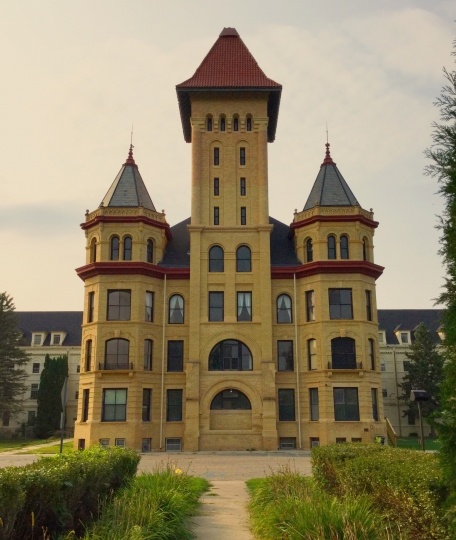
Fergus Falls Regional Treatment Center
Fergus Falls Regional Treatment Center, formerly Fergus Falls State Hospital. Photograph by Wikimedia Commons user HRS, August 20, 2019. CC BY-SA 4.0
Holding Location
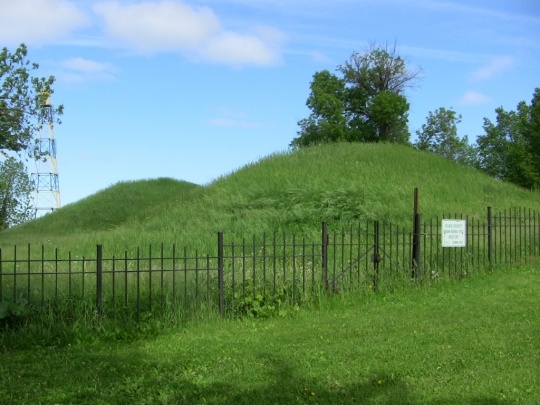
Mounds at Indian Mounds Park
Indian Mounds Park, 2016. Photograph by Paul Nelson.
All rights reserved
Holding Location
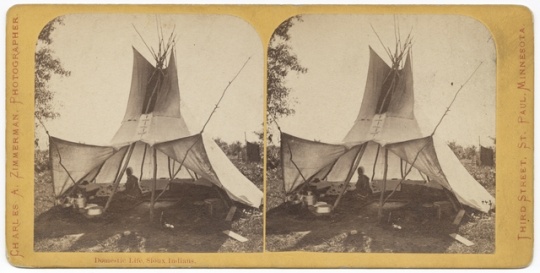
Interior of a Dakota tipi
Interior of a Dakota tipi, ca. 1880. Photograph by Charles Zimmerman.
Holding Location
More Information

An Ojibwe family standing by bull rush wigwam
An Ojibwe family standing by a bull rush wigwam, c.1910.
Public domain
Holding Location
More Information
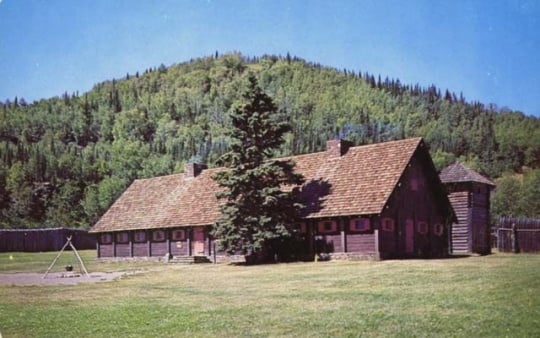
Great Hall, Grand Portage National Monument
The reconstructed Great Hall and stockade at Grand Portage, ca. 1955.
Holding Location
More Information
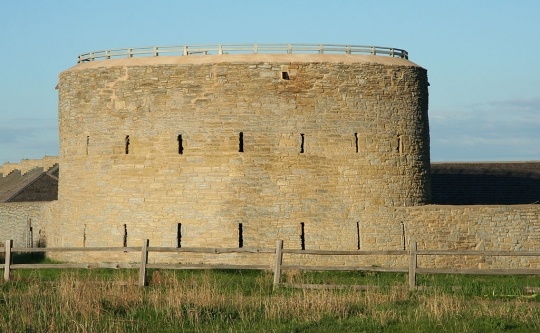
Round Tower, Historic Fort Snelling
The Round Tower at Historic Fort Snelling, 2010. Photograph by Wikimedia Commons user Jonathunder.
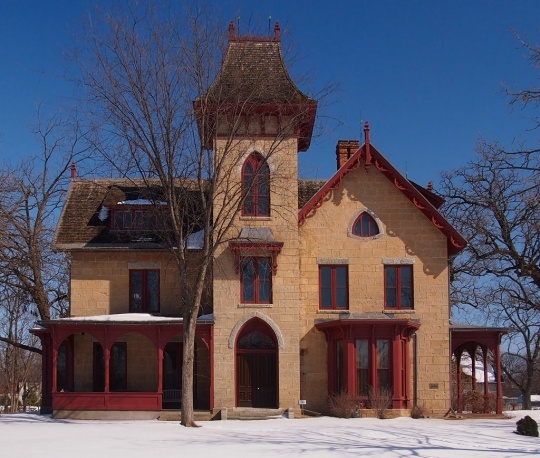
LeDuc Historic Estate
Front façade of the LeDuc historic estate in Hastings. Photograph by Wikimedia Commons user McGhiever, March 22, 2014. CC BY-SA 3.0.
Holding Location
More Information
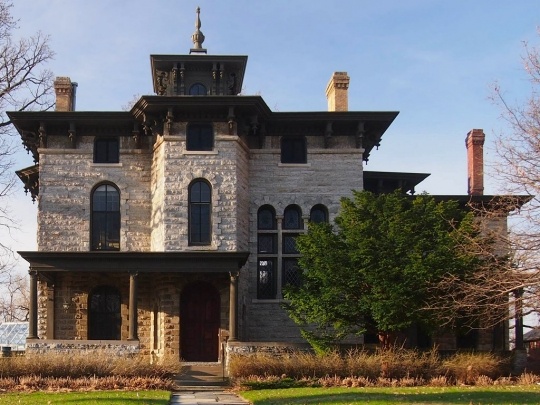
Burbank-Livingston-Griggs House
Burbank-Livingston-Griggs House, St. Paul, 2013. Photograph by Wikimedia Commons user McGhiever.
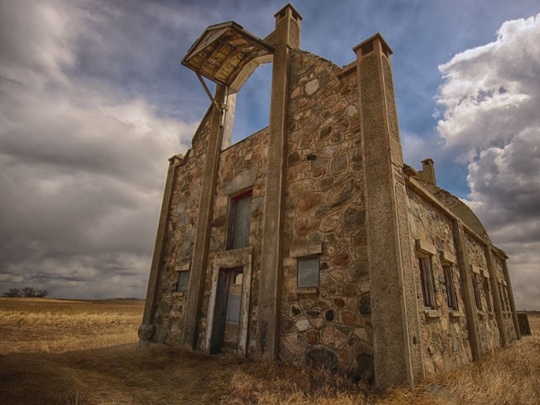
Schott Barn exterior (no roof)
The front side of the exterior of Schott Barn. Photographed on April 14, 2014, by Craig Voth.
All rights reserved
Holding Location
More Information
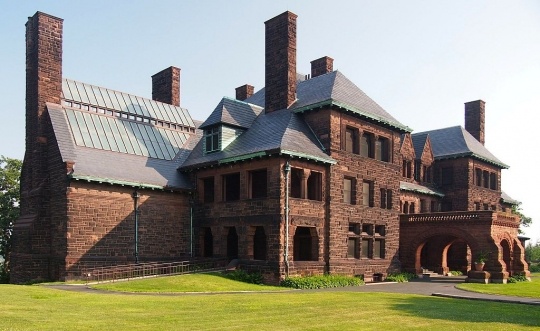
The James J. Hill House
James J. Hill House, 2013. Photograph by Wikimedia Commons user McGhiever.
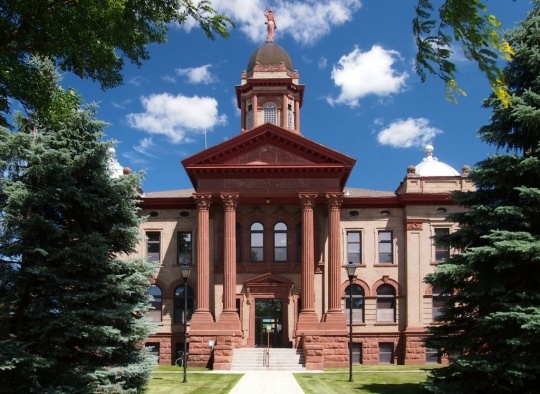
Cottonwood County Courthouse
Cottonwood County Courthouse, Windom. Photograph by Wikimedia Commons user McGhiever, July 2, 2014. Creative Commons BY-SA 3.0.
Holding Location
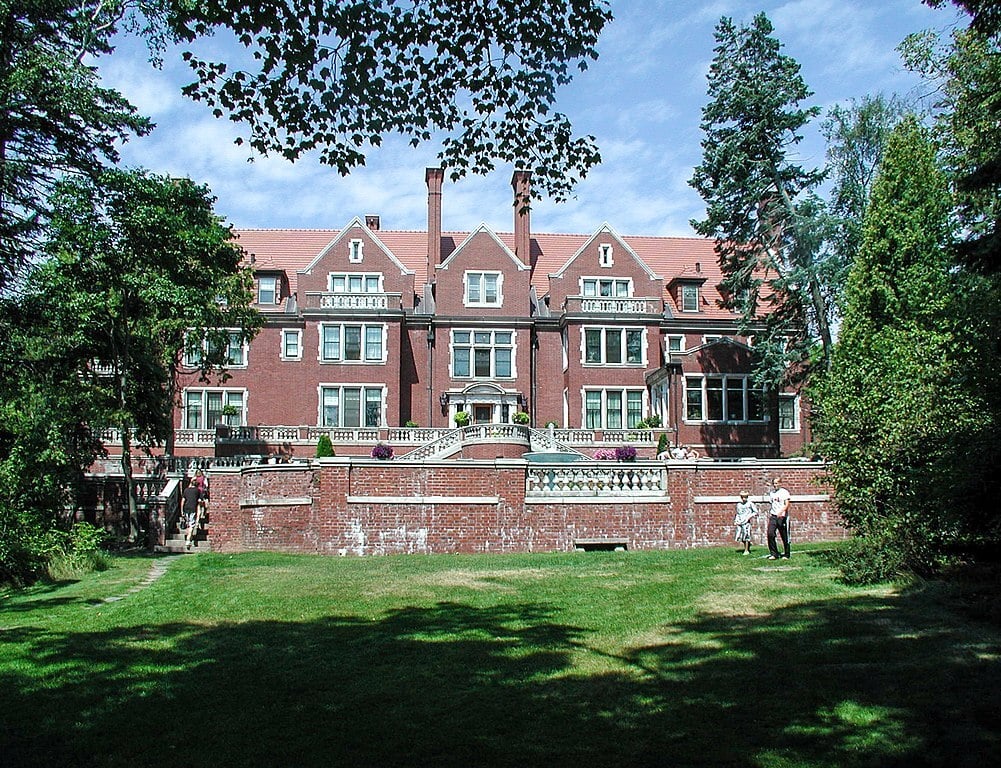
Glensheen historic estate
Glensheen historic estate, August 5, 2006. Photo by Wikimedia Commons user Derek Heidelberg.
Public domain
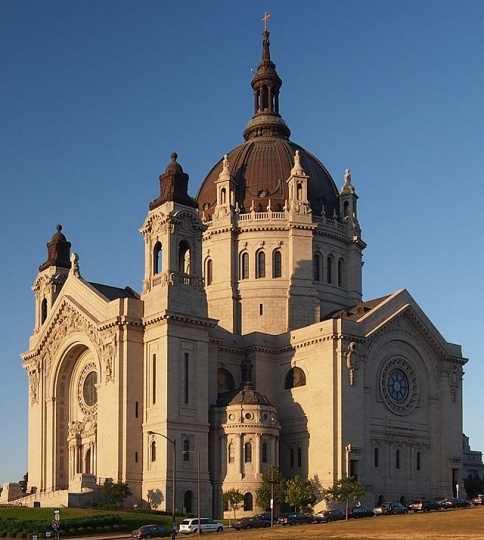
St. Paul Cathedral
View of St. Paul Cathedral from John Ireland Blvd. Photograph by Wikimedia Commons user McGhiever, 2012.

Sparre Round Barn
Sparre Round Barn (Nowthen, Minnesota), undated. Photographer unidentified. Anoka County Historical Society, Object ID# P2066.A10-001. Used with the permission of Anoka County Historical Society.
Holding Location
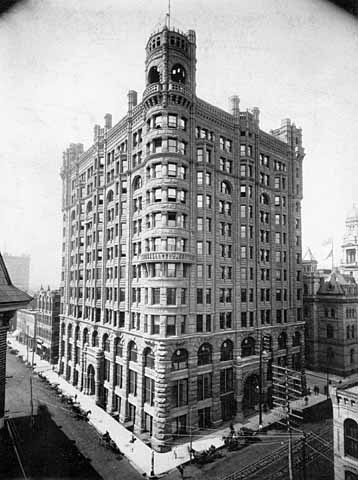
Northwestern Guaranty Loan Building
The Northwestern Guaranty Loan (later Metropolitan) Building, c.1892; it was the Twin Cities' tallest nineteenth-century skyscraper.
Public domain
Holding Location
More Information

Minnesota State Capitol
Minnesota State Capitol, September 8, 2017. Photograph by Wikimedia Commons user McGhiever. CC BY-SA 4.0.
Holding Location
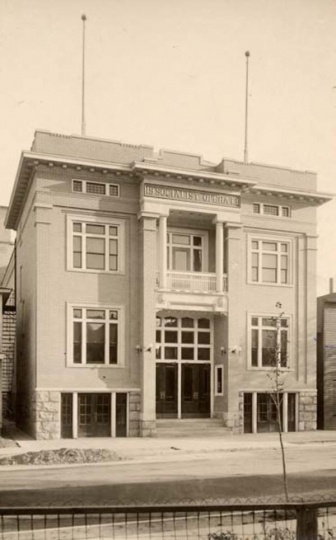
Socialist Opera House
Exterior view of the Socialist Opera building in Virginia, Minnesota. The grand opening of this building was on April 5-6, 1913. Used with permission from the Immigration History Research Center at the University of Minnesota.
All rights reserved
Holding Location
More Information
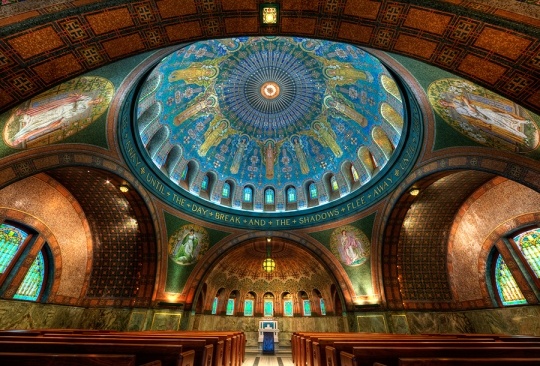
Lakewood Chapel dome interior, 2014
Lakewood Chapel interior, 2014. Photograph by Wayne Moran; used with the permission of Wayne Moran.
All rights reserved
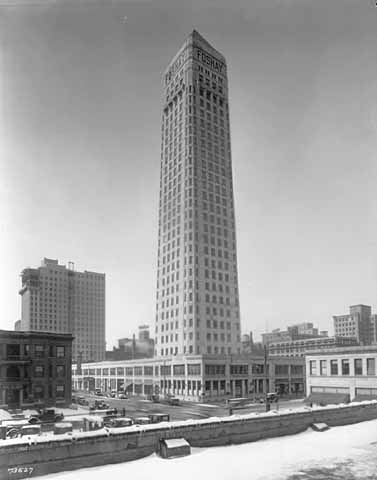
Foshay Tower, Minneapolis
Foshay Tower, 821 S. Marquette Avenue, Minneapolis, 1928–1929.
Holding Location
More Information
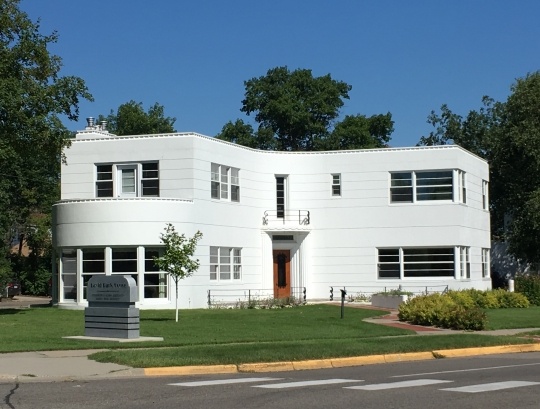
David Park House
The exterior of the David Park House, 2016. Photograph by Gary Rozman. Used with the permission of Beltrami County Historical Society.
Holding Location
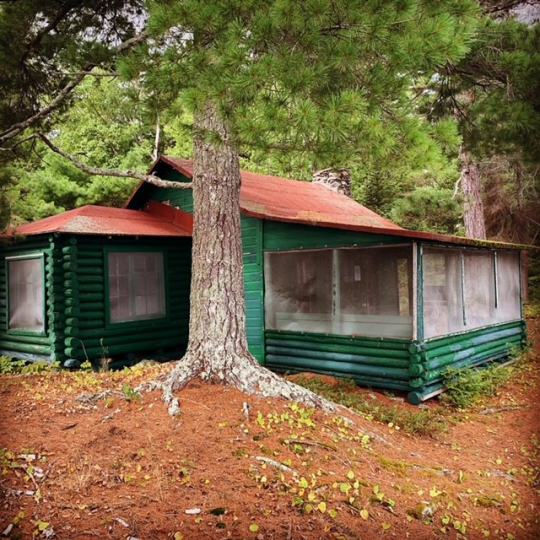
Jun Fujita’s cabin
Jun Fujita’s cabin on Rainy Lake in St. Louis County, Minnesota. Photograph by A. Wallace for the National Park Service, undated. Public domain.
Public domain
Holding Location
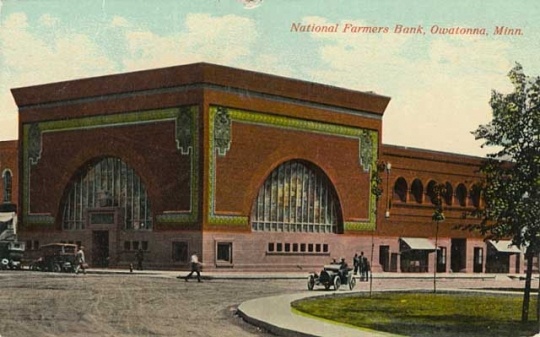
National Farmers Bank of Owatonna
A color postcard showing the National Farmers Bank of Owatonna, c.1920.
Public domain
Holding Location
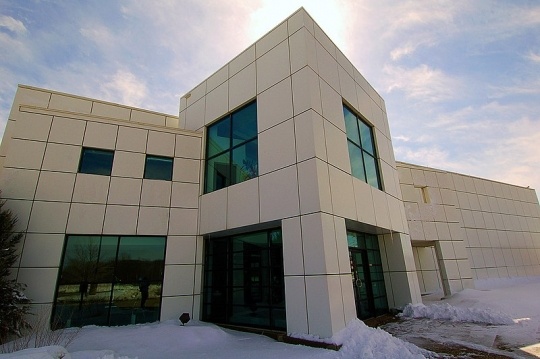
Exterior of Paisley Park
Exterior of Prince's Paisley Park complex in Chanhassen, 2008.
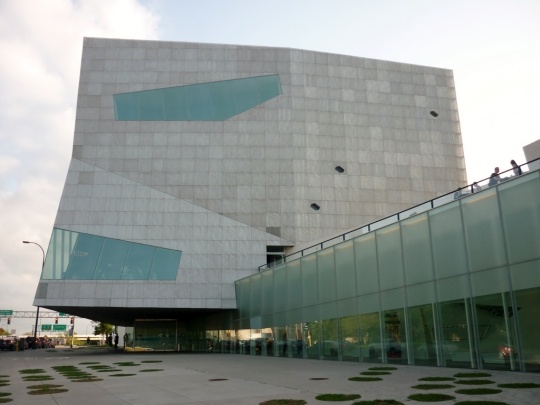
Walker Art Center
An exterior view of the Walker Art Center addition designed by Herzog & de Meuron in 2005. Photograph by Flickr user Mark B. Schlemmer, May 3, 2012. CC BY 2.0
Holding Location
More Information
Related Articles
Overview
American Indian burial mounds date back at least two thousand years.
The construction of Fort Snelling (1820–1825) inaugurates an age of white immigration.
The 1880s bring spectacular urban growth and new building types like the skyscraper.
Cass Gilbert and other architects raise design in Minnesota to a new level.
Beaux-Arts monuments lead to a "golden age" of architecture in the early 1900s.
Prairie School architects create a remarkable legacy of progressive design.
The first stirrings of architectural Modernism begin in the 1930s.
Modernism becomes the dominant architectural style in the decades after World War II.
"Starchitects" from around the world make their mark on Minnesota.
"Big boxes" fill the new suburbs.
Chronology
c.800 BCE
c.1780s
1820–1825
1880–1881
1905
1908
1956
1961–1962
1973
2007
Bibliography
Blank, Thomas R., and Charles Locks. "Launching a Career: Residential and Ecclesiastical Work from the St. Paul Office." In Cass Gilbert, Life and Work, edited by Barbara S. Christen and Steven Flanders, 46–61. New York: Norton, 2001.
Brooks, H. Allen. The Prairie School: Frank Lloyd Wright and his Midwest Contemporaries. 1972. Reprint, New York: Norton, 1976
Gebhard, David, and Tom Martinson. A Guide to the Architecture of Minnesota. Minneapolis: University of Minnesota Press, 1977.
Hudson, John C. Plains Country Towns. Minneapolis: University of Minnesota Press, 1985.
Larson, Paul Clifford. Minnesota Architect: The Life and Work of Clarence H. Johnston. Afton, MN: Afton Historical Society Press, 1996.
Lathrop, Alan. Minnesota Architects: A Biographical Dictionary. Minneapolis: University of Minnesota Press, 2010.
Millett, Larry. AIA Guide to the Twin Cities. St. Paul: Minnesota Historical Society Press, 2007.
———. The Curve of the Arch: The Story of Louis Sullivan's Owatonna Bank. St. Paul: Minnesota Historical Society Press, 1985.
———. Lost Twin Cities. St. Paul: Minnesota Historical Society Press, 1992.
Pennefeather, Shannon M., ed. Mill City: A Visual History of the Minneapolis Mill District. St. Paul: Minnesota Historical Society Press, 2003.
Sandeen, Ernest. St. Paul's Historic Summit Avenue. 1978. Reprint, Minneapolis: University of Minnesota Press, 2004.
Related Resources
Secondary
Atkins, Annette. "At Home in the Heart of the City." Minnesota History 58, nos. 5–6 (Spring/Summer 2003): 286–304.
http://collections.mnhs.org/MNHistoryMagazine/articles/58/v58i05-06p286-304.pdf
Banham, Reyner. A Concrete Atlantis: U.S. Industrial Building and European Modern Architecture, 1900–1925. Cambridge, MA: MIT Press, 1986.
Bennett, Edward H., with Andrew Wright Crawford. Plan of Minneapolis. Minneapolis: Minneapolis Civic Commission, 1917.
Benson, David R. Stories in Log and Stone: The Legacy of the New Deal in Minnesota State Parks. St. Paul: Minnesota Department of Natural Resources, 2002.
Berman, James, ed. St. Anthony Falls Rediscovered. Minneapolis: Minneapolis Riverfront Development Coordination Board, 1980.
Diers, John W., and Aaron Isaacs. Twin Cities by Trolley: The Streetcar Era in Minneapolis and St. Paul. Minneapolis: University of Minnesota Press, 2007.
Fisher, Thomas (with photographs by Peter Bastianelli-Kerze). Salmela Architect. Minneapolis: University of Minnesota Press, 2005.
Gardner, Denis P. Wood, Concrete, Stone, and Steel: Minnesota's Historic Bridges. Minneapolis: University of Minnesota Press, 2008.
Gebhard, David. Purcell & Elmslie, Prairie Progressive Architects. Salt Lake City: Gibbs Smith, 2006.
Glancy, Bob. "Florence Flirts with Fame and Fortune: Minneapolis's Richest Widow." Hennepin History (Winter 2007): 18–35.
Hatfield, Marshall R. "Lafayette Park and the Vanished Homes of St. Paul's Elite." Ramsey County History 29, 2 (Summer 1994): 4–21.
Hart, Joseph (with photographs by Edwin L. Hirschoff). Down and Out: The Life and Death of Minneapolis' Skid Row. Minneapolis: University of Minnesota Press, 2002.
Hess, Jeffrey A., and Paul Clifford Larson. St. Paul Architecture: A History. Minneapolis: University of Minnesota Press, 2006.
Hession, Jane King, Rip Rapson, and Bruce N. Wright. Ralph Rapson: Sixty Years of Modern Design. Afton, MN: Afton Historical Society Press, 1999.
Johnson, Frederic L. (with Thomas U. Tuttle). Suburban Dawn: The Emergence of Richfield, Edina and Bloomington. Richfield, MN: Richfield Historical Society, 2009.
Johnston, Patricia Condon. Stillwater: Minnesota's Birthplace in Photographs by John Runk. Afton, MN: Johnston Publishing, 1995.
Kane, Lucile M. The Falls of St. Anthony: The Waterfall That Built Minneapolis. 1966. Rev. ed., St. Paul: Minnesota Historical Society Press, 1987.
Kennedy, Roger G. Historic Homes of Minnesota. 1967. Rev. ed., St. Paul: Minnesota Historical Society Press, 2006.
Lathrop, Alan. Churches of Minnesota: An Illustrated Guide. Minneapolis: University of Minnesota Press, 2003.
Martin, Judith, and Antony Goddard. Past Choice/Present Landscapes: The Impact of Urban Renewal on the Twin Cities. Minneapolis: Center for Urban and Regional Affairs, 1989.
Millett, Larry (with photographs by Jerry Mathiason). Twin Cities Then and Now. St. Paul: Minnesota Historical Society Press, 1996.
Nelson, Paul D. "The Life and Death of Central Park-A Small Part of the Past Illuminated." Ramsey County History 39, 3 (Fall 2004): 4–16.
Nord, Mary Ann. The National Register of Historic Places in Minnesota: A Guide. St. Paul: Minnesota Historical Society Press, 2003.
Olivarez, Jennifer Komar (with Corine A. Wegener). Progressive Design in the Midwest: The Purcell-Cutts House and the Prairie School Collection at the Minneapolis Institute of Arts. Minneapolis: Minneapolis Institute of Arts, 2000.
O'Sullivan, Thomas. North Star Statehouse: An Armchair Guide to the Minnesota State Capitol. St. Paul: Pogo Press, 1994.
Pfaender, Jay. "Stonebridge: The Story of a Lost Estate and Oliver Crosby, the Inventive Genius Who Created It." Ramsey County History 40, 3 (Fall 2005): 4–19.
Prairie School Architecture in Minnesota, Iowa, Wisconsin. St. Paul: Minnesota Museum of Art, 1982.
Scott, James Allen. Duluth's Legacy: Architecture. Duluth, MN: City of Duluth, Department of Research and Planning, 1974.
Smith, David C. City of Parks: The Story of Minneapolis Parks. Minneapolis: The Foundation for Minneapolis Parks, 2008.
Snow, Julie. Julie Snow, Architect. Princeton, NJ: Princeton Architectural Press, 2005.
Storrer, William Allin. The Frank Lloyd Wright Companion. Chicago: University of Chicago Press, 1993.
Tishler, William H., and Virginia S. Luckhart. "H.W.S. Cleveland, Pioneer Landscape Architect of the Upper Midwest." Minnesota History 49, no. 7 (Fall 1985): 281–91.
http://collections.mnhs.org/MNHistoryMagazine/articles/49/v49i07p281-291.pdf
Vandam, Elizabeth. Harry Wild Jones, American Architect. Minneapolis: Nodin Press, 2008.
Westbrook, Nicolas, ed. A Guide to the Industrial Archaeology of the Twin Cities. St. Paul and Minneapolis: Society for Industrial Archaeology, 1983.
Web
The Architecture of the Twin Cities.
http://www.citiesarchitecture.com/
The Commercial Real Estate Information and Construction Data.
http://www.emporis.com/
Hennepin County Library. City of Minneapolis Photo Collection.
https://digitalcollections.hclib.org/digital/collection/CPED/search
The Minneapolis Institute of Arts. Unified Vision: The Architecture and Design of the Prairie School.
http://www.artsmia.org/unified-vision/
The Minnesota Architecture Guide.
http://eng.archinform.net/ort/2847.htm
The Minnesota Historical Society. Alexander Ramsey House.
http://sites.mnhs.org/historic-sites/alexander-ramsey-house
The National Park Service. Grand Portage.
http://www.nps.gov/grpo/index.htm
The National Park Service. Pipestone Commercial Historic District.
http://www.nps.gov/nr/travel/pipestone/phd.htm
The University of Minnesota Libraries. Northwest Architectural Archives.
https://www.lib.umn.edu/collections/special/naa
The Willey House.
http://www.thewilleyhouse.com/

























